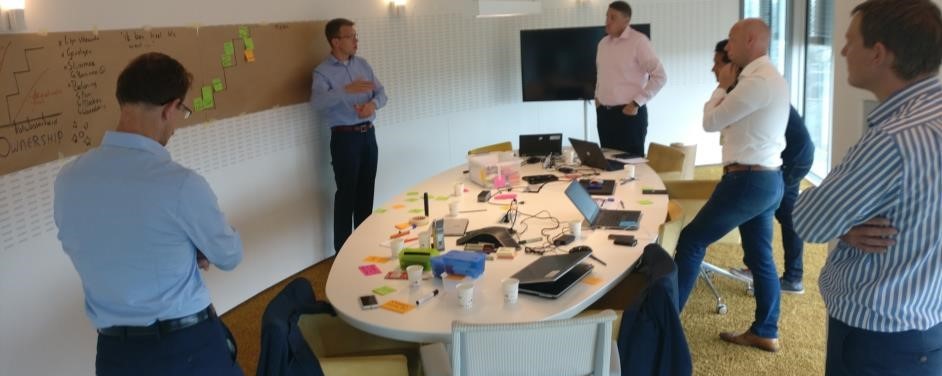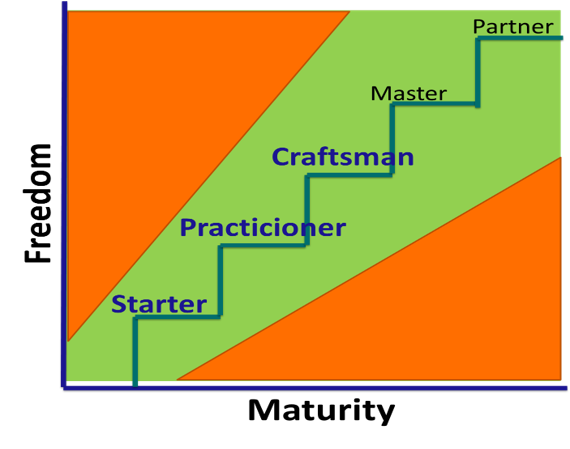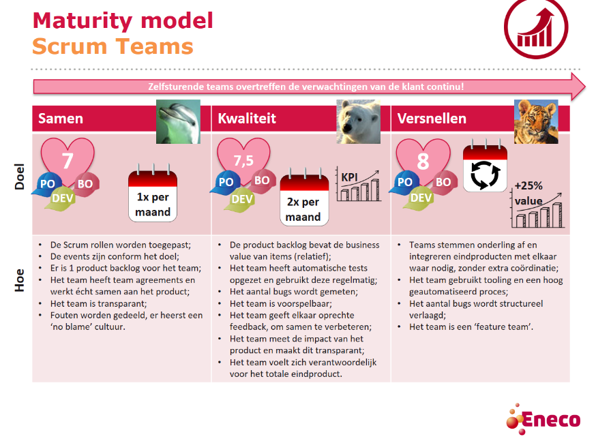
Practical example of the Ownership Model
Let's build high performing teams
Working in a high performing team is great. With your team you have the freedom you need to focus and organize your work. There is a minimum set of rules, standards and bureaucracy. And there is a clear and visible goal to strive for. You take charge for your personal- and your team development.
WHY is Ownership key
- The more a team takes ownership, the faster the team can make their own decisions, come with better solutions and have a can-do mentality to improve. Key for managers is to stimulate and facilitate this.
- Taking ownership. That’s they key. Yet sometimes teams feel their progress towards high performance is hampered due to a lack of freedom and organizational constraints. Applying the Ownership model will help with tackling this and acceleration towards high performance.
Ownership model
To help a team grow, to create clarity on what to improve next, the bank adopted the Ownership model. In this model, teams grow from basecamp towards 5 levels of ownership:
- Starter – predictable output and happy stakeholders
- Practitioner - fully DevOps and delivering high quality
- Craftsman – coaching other teams to improve
- Master - delivers Business Value as value chain
- Partner – fully merged with the business, as one – Pinnacle state
HOW does it work?
- Teams decide on their own steps and targets
- With more maturity, comes more freedom
- Some of the criteria per level are predefined by L&I
- Team apply themselves for promotions
- The ‘jury’ consists of IT colleagues from L&I
- If a team is promoted, it will set targets for this level, and consolidate the achieved improvements so far.
How does the model look like?

| Criteria | 😀 | FR | Quality | KVI |
| Who | PO, SM, Dev | SM | PO | |
| Starter | ≥ 7 | ≥ 80% | Measure (SMART) | |
| Practicioner | ≥ 7 | Achieve | Known | |
| Craftsman | ≥ 7½ | Achieve + | ||
| Master | ≥ 7½ | Achieve ++ | Achieve | |
| Partner | ≥ 8 | Achieve+ |
Explenation
- 😀 - Happiness Product Owner, Stakeholders and DevOpsTeam – after each sprint they all give their happiness,
- FR - Forecasted vs Realized – The % of the – during sprint planning – forecasted storypoints that are Done (conform DoD).
- Q - Quality – what is the perceived quality from users and how do we measure it? The metric is decided by the PO, DM and DT. The tangible metric differs per team. Ex. #severe-defects, #automatic-tested-bugs, etc.
- KVI – Key Value Indicator. What is ‘winning the match’? Ex. #manual-actions, #visotors, #daily users, %conversion, Turnover, NPS, etc.
How did it work?
The Ownership-model wasn't created by managers-only. A group of Scrum Masters collaborated together and created a first version of the Ownership-Model. Based on the vision of the it-managers on what they saw as a great team.
A great team or high-performing-team, is a team where:
- Have high craftsmanship standards, deliver high quality,
- Don't focus on their own team, they help other teams to grow. They collaborate with teams left and right in the value stream and together deliver more value,
- Have highly satisfied stakeholders and customers. Deliver 9+ customer journeys
Based on these points, they created the highest level; partner. They checked the model with some experienced developers, product owners and stakeholders. These people gave some points of feedback. But all-in-all where very enthousiastic.
Accelerators
They formed a group of Scrum Masters and Senior Developers, called Accelerators. These people met once every two weeks and discussed the vibe around the Ownership Model. Did teams tangible improve? Do teams need help? Is there enough attention from the managers to continuously improve?Celebrations
When a team reached a new level, the team got cake, a moment of fame during the department presentations and they could pick a present of their choice.Lessons learned after a few months
- It takes time to determine and implement the right quality criteria for progressing to the next level (incorporate in way of working).
- Create team awareness through discussions on behavior, not so much focus on content (not the typical retro).
- Keep it alive - after a few months the vibe went down. Managers got stuck in every-day busyness. It takes discipline, belief and consistency to keep it alive after months.
- Use the voice of the stakeholders - especially when stakeholders where enthusiastic about growth and progress and how that benefits them was an important moment to emphasize the importance of growth and ownership.




